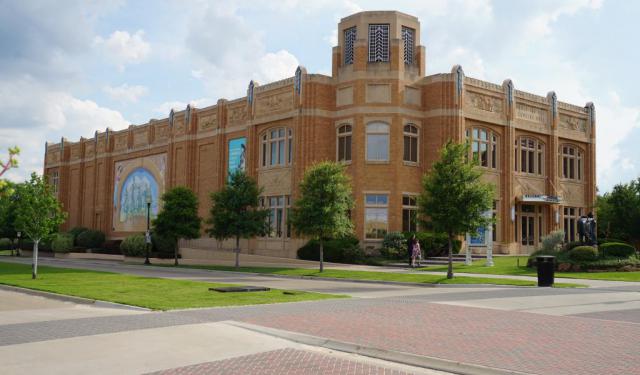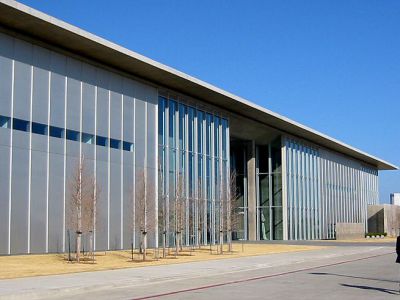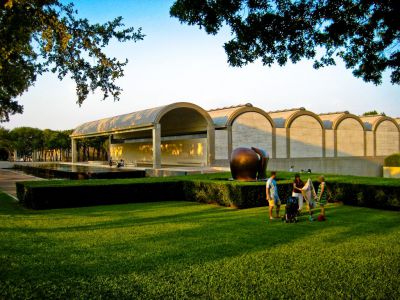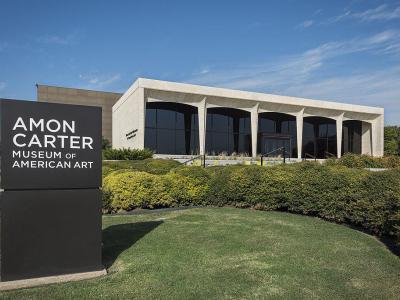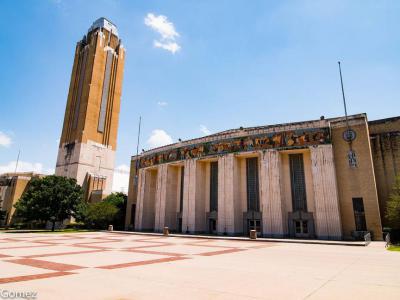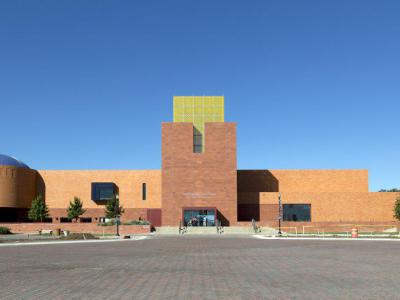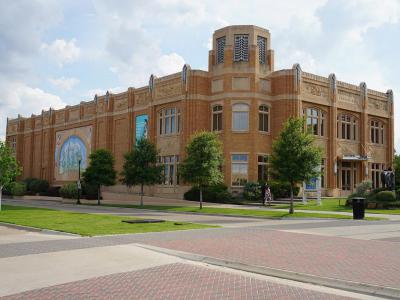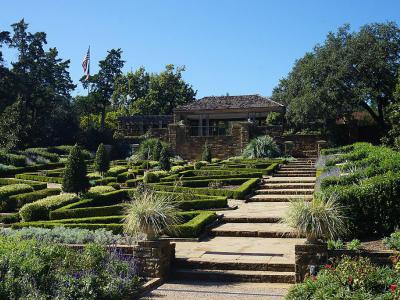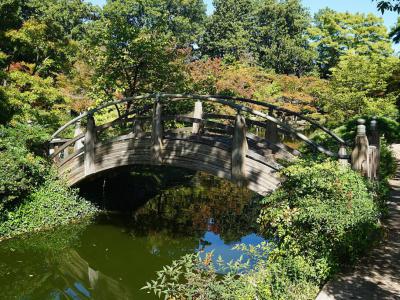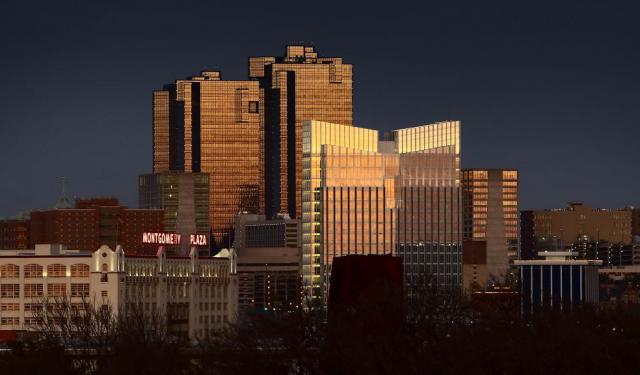Cultural District Walking Tour (Self Guided), Fort Worth
Just minutes away from the hustle and bustle of the downtown's daily commerce, the Fort Worth Cultural District is a true gem deep in the heart of the city. Bordered by a tree lined boulevard paved with bricks and surrounded by manicured grounds, the area is alive with charming shops and restaurants.
But most importantly, the district is a home to the five prominent museums, such as the architecturally striking Modern Art Museum of Fort Worth; the Kimbell Art Museum – boasting a wealth of European paintings and priceless antiquities; the Fort Worth Museum of Science and History; the Amon Carter Museum; and the National Cowgirl Museum and Hall of Fame – honoring the courageous women of the American West whose pioneer spirit was instrumental in their trail blazing efforts.
The abundance of the world-class collections of artworks from America and around the world, spanning virtually the entire history of art, as well as exotic science and cultural exhibits, have earned the area the title of the "museum capital of the Southwest".
Alongside these diverse collections, you will also find in the Cultural District acclaimed theaters with exciting performances and the much loved by so many Will Rogers Memorial Center – a place of the Annual Fort Worth Stock Show, rodeos, and other events.
Those in favor of natural masterpieces will undoubtedly enjoy the Fort Worth Botanic Gardens with its Japanese Garden section and other floral delights.
Since all of these celebrated attractions are within walking distance, you can easily explore them on foot. To find inspiration, broaden your horizons and spend quality time in a beautiful, park-like setting, take this self-guided walk and enjoy the rich heritage of Fort Worth's wonderful Cultural District.
But most importantly, the district is a home to the five prominent museums, such as the architecturally striking Modern Art Museum of Fort Worth; the Kimbell Art Museum – boasting a wealth of European paintings and priceless antiquities; the Fort Worth Museum of Science and History; the Amon Carter Museum; and the National Cowgirl Museum and Hall of Fame – honoring the courageous women of the American West whose pioneer spirit was instrumental in their trail blazing efforts.
The abundance of the world-class collections of artworks from America and around the world, spanning virtually the entire history of art, as well as exotic science and cultural exhibits, have earned the area the title of the "museum capital of the Southwest".
Alongside these diverse collections, you will also find in the Cultural District acclaimed theaters with exciting performances and the much loved by so many Will Rogers Memorial Center – a place of the Annual Fort Worth Stock Show, rodeos, and other events.
Those in favor of natural masterpieces will undoubtedly enjoy the Fort Worth Botanic Gardens with its Japanese Garden section and other floral delights.
Since all of these celebrated attractions are within walking distance, you can easily explore them on foot. To find inspiration, broaden your horizons and spend quality time in a beautiful, park-like setting, take this self-guided walk and enjoy the rich heritage of Fort Worth's wonderful Cultural District.
How it works: Download the app "GPSmyCity: Walks in 1K+ Cities" from Apple App Store or Google Play Store to your mobile phone or tablet. The app turns your mobile device into a personal tour guide and its built-in GPS navigation functions guide you from one tour stop to next. The app works offline, so no data plan is needed when traveling abroad.
Cultural District Walking Tour Map
Guide Name: Cultural District Walking Tour
Guide Location: USA » Fort Worth (See other walking tours in Fort Worth)
Guide Type: Self-guided Walking Tour (Sightseeing)
# of Attractions: 8
Tour Duration: 2 Hour(s)
Travel Distance: 3.5 Km or 2.2 Miles
Author: ChristineR
Sight(s) Featured in This Guide:
Guide Location: USA » Fort Worth (See other walking tours in Fort Worth)
Guide Type: Self-guided Walking Tour (Sightseeing)
# of Attractions: 8
Tour Duration: 2 Hour(s)
Travel Distance: 3.5 Km or 2.2 Miles
Author: ChristineR
Sight(s) Featured in This Guide:
- Modern Art Museum of Fort Worth
- Kimbell Art Museum
- Amon Carter Museum of American Art
- Will Rogers Memorial Center
- Fort Worth Museum of Science and History
- National Cowgirl Museum & Hall of Fame
- Fort Worth Botanic Garden
- Fort Worth Japanese Garden
1) Modern Art Museum of Fort Worth
The Modern Art Museum of Fort Worth, commonly known as The Modern, specializes in international modern and contemporary art, showcasing significant artistic developments from the post-World War II period to the present day. Its current building, inaugurated in December 2002, was designed by the renowned Japanese architect Tadao Ando in collaboration with former chief curator Michael Auping, named as the Best Designed Building in Texas in 2019 by the international magazine Architectural Digest.
The museum’s permanent collection consists of over 3,000 works, predominantly representing artistic movements and styles from 1945 onward. Visitors can explore pieces that exemplify abstract expressionism, color field painting, pop art, minimalism, new image painting from the 1970s, and recent trends in figurative sculpture, photography, video, and digital art. Notable artists featured include Pablo Picasso, Jackson Pollock, Andy Warhol, Gerhard Richter, Richard Serra etc.
In recent years, The Modern has expanded its collection with contemporary works by artists such as Kaws, Njideka Akunyili Crosby, and Wangechi Mutu. Beyond the exhibitions, the museum offers visitors Café Modern, a full-service restaurant and bar. Guests can dine inside or choose seating on the spacious outdoor patio.
The museum’s permanent collection consists of over 3,000 works, predominantly representing artistic movements and styles from 1945 onward. Visitors can explore pieces that exemplify abstract expressionism, color field painting, pop art, minimalism, new image painting from the 1970s, and recent trends in figurative sculpture, photography, video, and digital art. Notable artists featured include Pablo Picasso, Jackson Pollock, Andy Warhol, Gerhard Richter, Richard Serra etc.
In recent years, The Modern has expanded its collection with contemporary works by artists such as Kaws, Njideka Akunyili Crosby, and Wangechi Mutu. Beyond the exhibitions, the museum offers visitors Café Modern, a full-service restaurant and bar. Guests can dine inside or choose seating on the spacious outdoor patio.
2) Kimbell Art Museum (must see)
The Kimbell Art Museum in Fort Worth, hosts a small but excellent art collection as well as traveling art exhibitions, educational programs and an extensive research library. Its initial artwork came from the private collection of Kay and Velma Kimbell, who also provided funds for a new building to house it.
The building was designed by renowned architect Louis I. Kahn and is widely recognized as one of the most significant works of architecture of recent times. It is especially noted for the wash of silvery natural light across its vaulted gallery ceilings.
The European collection is the most extensive in the museum and includes Michelangelo's first known painting, The Torment of Saint Anthony, the only painting by Michelangelo on exhibit in the Americas.
The museum also houses a substantial library with over 59,000 books, periodicals and auction catalogs that are available as a resource to art historians and to faculty and graduate students from surrounding universities.
The building was designed by renowned architect Louis I. Kahn and is widely recognized as one of the most significant works of architecture of recent times. It is especially noted for the wash of silvery natural light across its vaulted gallery ceilings.
The European collection is the most extensive in the museum and includes Michelangelo's first known painting, The Torment of Saint Anthony, the only painting by Michelangelo on exhibit in the Americas.
The museum also houses a substantial library with over 59,000 books, periodicals and auction catalogs that are available as a resource to art historians and to faculty and graduate students from surrounding universities.
Sight description based on Wikipedia.
3) Amon Carter Museum of American Art (must see)
The Amon Carter Museum of American Art presents American artistic production from the early 19th century to the present, with a focus on works created in the United States and its territories. Established in 1961 with a core collection of over 300 works by Frederic Remington and Charles M. Russell, the museum has grown to include thousands of paintings, sculptures, photographs, and works on paper.
Remington and Russell remain central to the museum’s holdings, offering portrayals of the Old West rooted in observation, travel, and imagination. The museum also holds extensive materials from 19th-century expeditionary artists and Hudson River School painters, with additional attention to American Impressionism, modernism, and documentary art. Visitors can view rotating selections from the permanent collection, which includes photography, still life, portraiture, and genre scenes. Highlights range from Eakins’ Swimming to Sargent’s formal portraits and Nevelson’s large-scale wood assemblage.
The museum is also known for its photography archive, with more than 350,000 works spanning early daguerreotypes to contemporary images, including complete sets by Richard Avedon and Edward Curtis. Its drawings and prints encompass both field studies and fine art lithographs, while the sculpture collection includes works in bronze, marble, and modern materials from the 19th and 20th centuries.
Remington and Russell remain central to the museum’s holdings, offering portrayals of the Old West rooted in observation, travel, and imagination. The museum also holds extensive materials from 19th-century expeditionary artists and Hudson River School painters, with additional attention to American Impressionism, modernism, and documentary art. Visitors can view rotating selections from the permanent collection, which includes photography, still life, portraiture, and genre scenes. Highlights range from Eakins’ Swimming to Sargent’s formal portraits and Nevelson’s large-scale wood assemblage.
The museum is also known for its photography archive, with more than 350,000 works spanning early daguerreotypes to contemporary images, including complete sets by Richard Avedon and Edward Curtis. Its drawings and prints encompass both field studies and fine art lithographs, while the sculpture collection includes works in bronze, marble, and modern materials from the 19th and 20th centuries.
4) Will Rogers Memorial Center
The Will Rogers Memorial Center is a large entertainment and livestock complex established in 1936. Named after the American humorist Will Rogers, the facility includes over 120 acres of exhibition halls, arenas, and performance spaces. It was designed by architect Wyatt C. Hedrick in the Art Deco style, and features the well-known sculpture Riding into the Sunset by Electra Waggoner Biggs, unveiled in 1947. In 2016, the site was added to the National Register of Historic Places.
The center regularly hosts national and international events, particularly in equestrian and agricultural fields. Among its annual highlights are the Fort Worth Stock Show & Rodeo, the National Reined Cow Horse Association Snaffle Bit Futurity, and major competitions from the National Cutting Horse Association. The Center also includes facilities such as the Will Rogers Coliseum, the Equestrian Center, and multiple exhibit and arena spaces.
The center regularly hosts national and international events, particularly in equestrian and agricultural fields. Among its annual highlights are the Fort Worth Stock Show & Rodeo, the National Reined Cow Horse Association Snaffle Bit Futurity, and major competitions from the National Cutting Horse Association. The Center also includes facilities such as the Will Rogers Coliseum, the Equestrian Center, and multiple exhibit and arena spaces.
5) Fort Worth Museum of Science and History
The Fort Worth Museum of Science and History first opened its doors in 1945 as the Fort Worth Children's Museum and has since evolved into a comprehensive institution dedicated to science, history, and interactive learning. After moving to its current, the museum adopted its present name in 1968. After a major renovation in 2009, the new structure integrates elements from the original facility, including the preserved Omni Theater and a tree from the museum's original courtyard, now part of the Heritage Courtyard.
Inside, the museum houses a range of permanent and temporary exhibitions. The Fort Worth Children's Museum caters to young learners up to age eight, while the Cattle Raisers Museum on the second floor focuses on the history of the cattle industry. The Energy Blast exhibit addresses energy production and use, while DinoLabs and DinoDig offer a hands-on look at paleontology. Innovation Studios provide five glass-walled spaces-Inventor, Doodler, Designer, Imaginer, and Explorer-designed for hands-on experimentation. The Noble Planetarium and its adjacent space gallery explore astronomy and space history, including artifacts from the space race.
Inside, the museum houses a range of permanent and temporary exhibitions. The Fort Worth Children's Museum caters to young learners up to age eight, while the Cattle Raisers Museum on the second floor focuses on the history of the cattle industry. The Energy Blast exhibit addresses energy production and use, while DinoLabs and DinoDig offer a hands-on look at paleontology. Innovation Studios provide five glass-walled spaces-Inventor, Doodler, Designer, Imaginer, and Explorer-designed for hands-on experimentation. The Noble Planetarium and its adjacent space gallery explore astronomy and space history, including artifacts from the space race.
6) National Cowgirl Museum & Hall of Fame
The National Cowgirl Museum and Hall of Fame is a museum and association which honors women of the American West who have displayed courage or spirit and who have distinguished themselves while exemplifying the pioneer spirit. The facility is located in the Cultural District of Fort Worth adjacent to the Fort Worth Museum of Science and History.
The museum was begun in the small basement of the library in Hereford, the seat of Deaf Smith County in West Texas by Margaret Clark Formby (1929–2003), wife of the radio broadcaster Clint Formby. Formby sought for a larger city to take over the exhibits, and Fort Worth won the competition. Formby's husband's uncle was the Texas politician Marshall Formby, a state senator, highway commissioner, and gubernatorial candidate.
The museum was begun in the small basement of the library in Hereford, the seat of Deaf Smith County in West Texas by Margaret Clark Formby (1929–2003), wife of the radio broadcaster Clint Formby. Formby sought for a larger city to take over the exhibits, and Fort Worth won the competition. Formby's husband's uncle was the Texas politician Marshall Formby, a state senator, highway commissioner, and gubernatorial candidate.
Sight description based on Wikipedia.
7) Fort Worth Botanic Garden (must see)
The Fort Worth Botanic Garden is the oldest major botanic garden in Texas. Work began on the botanic garden in 1929 and was completed in 1934. It was designed by the Hare & Hare architectural firm in a Renaissance style.
The botanic garden includes a wide range of garden styles to display the largest possible variety of plant life. The most popular gardens are the Fuller Garden, which is often used for weddings; the Rose Gardens, which have hundreds of rose varieties and the Japanese Garden, which is seven acres of koi ponds, waterfalls, teahouses, pavilions and cherry trees.
The Back Yard Vegetable Garden, as the name suggests, is a vegetable garden that grows many different species. It also hosts educational programs for those who wish to begin urban gardening. The Trial Garden is another educational experience where hundreds of species of perennials are evaluated.
Other gardens include the Conservatory, Four Seasons Garden, Fragrance Garden, Native Texas Boardwalk, Perennial Garden, Rock Springs, Water Conservation Garden and the Water Wise Entrance.
The botanic garden includes a wide range of garden styles to display the largest possible variety of plant life. The most popular gardens are the Fuller Garden, which is often used for weddings; the Rose Gardens, which have hundreds of rose varieties and the Japanese Garden, which is seven acres of koi ponds, waterfalls, teahouses, pavilions and cherry trees.
The Back Yard Vegetable Garden, as the name suggests, is a vegetable garden that grows many different species. It also hosts educational programs for those who wish to begin urban gardening. The Trial Garden is another educational experience where hundreds of species of perennials are evaluated.
Other gardens include the Conservatory, Four Seasons Garden, Fragrance Garden, Native Texas Boardwalk, Perennial Garden, Rock Springs, Water Conservation Garden and the Water Wise Entrance.
8) Fort Worth Japanese Garden (must see)
The Fort Worth Japanese Garden is a 7.5-acre landscape designed in the style of a traditional Japanese strolling garden. Built in a former gravel pit in the early 1970s, its transformation was led by Kingsley K. Wu. The garden integrates multiple design styles found in classical Japanese gardening, including hill-and-pond, dry landscape, tea garden, and enclosed garden formats. At its center lies a series of interconnected ponds surrounded by hills, bridges, walkways, and structures inspired by Japanese religious, imperial, and domestic architecture.
Distinct features include a karesansui-style dry garden modeled after Kyoto’s Ryoanji temple, a moon-viewing deck, and a Shinto shrine-inspired pavilion. An authentic Mikoshi-an ornate palanquin donated by Nagaoka-remains on display. The garden also contains two karesansui compositions intended to resemble rivers, one alluding to the Colorado River and the Grand Canyon. Visitors encounter cherry trees, bamboo groves, Japanese maples, and koi-filled ponds as they follow the winding paths. Additional structures, including a pagoda, viewing platforms, and the enclosed Suzuki Garden.
The garden hosts two seasonal festivals-spring and fall-focused on traditional Japanese arts and cultural demonstrations. These events are typically held around the Moon-Viewing Deck, which features an amphitheatre and a taijitu symbol embossed in concrete.
Distinct features include a karesansui-style dry garden modeled after Kyoto’s Ryoanji temple, a moon-viewing deck, and a Shinto shrine-inspired pavilion. An authentic Mikoshi-an ornate palanquin donated by Nagaoka-remains on display. The garden also contains two karesansui compositions intended to resemble rivers, one alluding to the Colorado River and the Grand Canyon. Visitors encounter cherry trees, bamboo groves, Japanese maples, and koi-filled ponds as they follow the winding paths. Additional structures, including a pagoda, viewing platforms, and the enclosed Suzuki Garden.
The garden hosts two seasonal festivals-spring and fall-focused on traditional Japanese arts and cultural demonstrations. These events are typically held around the Moon-Viewing Deck, which features an amphitheatre and a taijitu symbol embossed in concrete.
Walking Tours in Fort Worth, Texas
Create Your Own Walk in Fort Worth
Creating your own self-guided walk in Fort Worth is easy and fun. Choose the city attractions that you want to see and a walk route map will be created just for you. You can even set your hotel as the start point of the walk.
Stockyards Cowtown Walking Tour
Once a major livestock center and a home to cowboys, cattlemen and outlaws, Fort Worth, TX has fully lived up to its nickname – “Cowtown.” From the late 1870s through the mid 1980s, the Fort Worth Stockyards made the city famous, drawing cattle from all over the state. Today mainly inactive, the Stockyards – "the last standing stockyards in the United States" – celebrates Fort... view more
Tour Duration: 1 Hour(s)
Travel Distance: 0.8 Km or 0.5 Miles
Tour Duration: 1 Hour(s)
Travel Distance: 0.8 Km or 0.5 Miles
Fort Worth Historical Buildings
Among the many ways to explore the richness of heritage fabric in Fort Worth there is one by historical architecture. Back in the 1920s-30s, the majority of Fort Worth’s notable buildings were designed by either Sanguinet & Staats or Wyatt Hedrick.
The former, in particular, were responsible for creating, among other structures, the Flatiron – one of the first high-risers in Fort Worth.... view more
Tour Duration: 2 Hour(s)
Travel Distance: 3.5 Km or 2.2 Miles
The former, in particular, were responsible for creating, among other structures, the Flatiron – one of the first high-risers in Fort Worth.... view more
Tour Duration: 2 Hour(s)
Travel Distance: 3.5 Km or 2.2 Miles
Fort Worth Introduction Walk
At over 900,000 people in the city proper and more than 7 million in the metro area, Fort Worth is one of the largest cities in the country. This now booming metropolis had a surprisingly meager start less than 200 years ago.
The history of Fort Worth began in 1849 with the establishment of a fort to protect the frontier after the Mexican-American War. Fort Worth was just one fortification in a... view more
Tour Duration: 1 Hour(s)
Travel Distance: 1.5 Km or 0.9 Miles
The history of Fort Worth began in 1849 with the establishment of a fort to protect the frontier after the Mexican-American War. Fort Worth was just one fortification in a... view more
Tour Duration: 1 Hour(s)
Travel Distance: 1.5 Km or 0.9 Miles
The Most Popular Cities
/ view all
